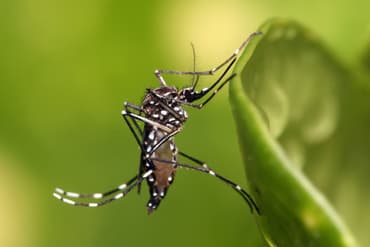-

Skin Sprays vs. Outdoor Repellers: Which provides better mosquito protection?
Dec 18, 2025 -

Fortune Media and Great Place To Work Name Thermacell Repellents to 2025 Best Workplaces in Manufacturing & Production List
Sep 12, 2025 -

Thermacell® Introduces the E65 Rechargeable Mosquito Repeller + Fast Charging Dock to Extend Your Time Outdoors
Aug 20, 2025

Effective Mosquito Control Strategies to Fight the Bite This Summer
When it comes to dealing with mosquitoes, it's more than just swatting them away; it's about strategically managing their numbers. This article shares effective mosquito treatment methods targeting larvae and adult mosquitoes around your living spaces, while limiting excessive chemical use. Discover practical strategies for a safer, mosquito-free summer.
Out with Mosquito Control and in With Mosquito Management
Let’s start off on the right foot. Mosquito control is starting to be a dated term that carries the weight of historical chemical use, and it also implies that 100% eradication is possible. The modern methodology is ‘integrated mosquito management.’ The integrated approach relies on public education, surveillance, resistance monitoring, and mosquito treatment. Both are commonly referring to professional-level methods, but there is plenty you can learn from for your home arsenal with treatments and repellents.
Mosquito Treatment VS Mosquito Repellent?
When it comes to managing mosquitoes in your own backyard, it's essential to differentiate between long-term treatment strategies and the immediate relief that repellents offer. Treatment methods work to reduce mosquito populations systematically by targeting their larval habitats or the adults that are present in the area. Treatment using larvicides and natural predators like fish target water-bound immature mosquitoes, whereas fully-grown mosquitoes are targeted using adulticides and promoting bird and bat habitats. These strategies are crafted for lasting mosquito suppression in outdoor spaces, contrasting with repellents that provide a quick yet temporary shield against mosquito bites when applied to your skin or clothing.
When thinking through a mosquito management strategy for your own home, treatments can create a great baseline to work in concert with repellents and repelling devices to create peaceful evenings.
Understanding Mosquito Biology and Behavior
Before we dive into the various ways to manage mosquitoes, it's crucial to grasp their behavior and biology. This understanding helps in developing effective mosquito management strategies that take into account their habitats, life cycle, and activity patterns.
The Lifecycle of a Mosquito
The mosquito's lifecycle unfolds through four key stages:
- The egg stage
- The larva stage
- The pupa stage
- Ultimately, the adult stage
While it will vary by species of mosquito, female mosquitos will lay their eggs either in, or on water. They will lay dozens to hundreds of eggs at a time and will float on the top of the water until they hatch. Even a small amount of water can attract female mosquitoes, so it’s essential to keep an eye out for stagnant water around your home. Once the eggs hatch, they feed on water microorganisms and transform into pupae after three molts. Pupae continue their development until the newly formed adult flying mosquito emerges from the pupal skin and exits the water. After emerging, male mosquitoes feed on nectar, while females feed on nectar and require blood-feeding to lay eggs. Female mosquitoes seek water to lay their eggs, within their flight range.
FUN FACT
Aedes mosquitoes have a flight range of less than 700 feet, but Culex can be 1-2 miles, Anopheles can be 1-3 miles, and if we consider salt marsh mosquitoes, they can fly over 5 miles!!
Immature Mosquito Habitats
Natural aquatic environments like marshes and ponds, as well as man-made reservoirs such as unused tires, buckets, and birdbaths, can become breeding sites for mosquitoes. Spoiler alert, keeping your yard free of standing water, of even small amounts, can significantly reduce the mosquito population in your yard.
Mosquito Behavior Patterns
Various mosquito species display different behavior patterns. Some are active during the day, while others prefer the night. Mosquitoes typically peak in biting activity at dawn and dusk, known as crepuscular activity. It's important to consider environmental factors like temperature and humidity. Mosquitoes thrive in warm temperatures around 80°F. Relative humidity plays a crucial role in their activity - high humidity levels promote mosquito activity, whereas low humidity inhibits it and can even lead to mortality. Understanding these patterns and factors helps in planning and executing effective mosquito control strategies.
Mosquito Larvae Treatment Techniques
Focusing on the larvae is crucial for controlling mosquito populations. Targeting these immature stages—where they are concentrated, immobile, and more accessible—is highly effective in reducing overall mosquito numbers. This approach not only lowers the risk of diseases transmitted by adult mosquitoes but also minimizes environmental impacts and challenges associated with managing a more mobile adult mosquito population.
Source Reduction
This can be as simple as keeping an eye out and removing any standing water around your yard, even very small amounts in gutters, drains, trays beneath potted plants, tree holes, or even plants like bromeliads. If there's water you want to keep around in fountains or bird baths, just make sure it's changed out once a week (unless it's circulating already like a fountain). Looking for more tips like these? Check out our spring mosquito control tips.
Community Involvement
Engagement with the community and education in public health play vital roles in controlling mosquitoes. When communities are informed about diseases spread by mosquitoes, they can collectively improve their neighborhood’s outdoor experience. It can be helpful to see if your city or county has information on any efforts being made community-wide that you can contribute to.
Taking proactive measures to eliminate standing water, implementing effective waste management strategies, and organizing community trash clean-up activities can lead to significant advancements in reducing mosquito breeding habitats in your community. Encouraging the reduction or repurposing of items that could collect water helps prevent these areas from becoming fertile grounds for mosquitoes.
These efforts are vital in supporting communities as they collaborate with mosquito control districts to play a significant role in the collective endeavors to manage mosquito populations. By embracing such actions together, communities greatly contribute to reducing the risks associated with mosquitoes.
Adult Mosquito Treatment Techniques
Mosquito Management Services
Local pest control companies typically provide mosquito treatment services. These companies will often utilize pesticides on the vegetation surrounding your home. When mosquitoes land in your vegetation, the pesticide eliminates them on contact.
Mosquito Repelling Plants
Enhance your outdoor space by considering the great option of planting mosquito-repelling herbs. These natural deterrents not only add greenery but may possibly keep pesky mosquitoes at bay. Some excellent choices include Basil, Catnip, Citronella grass, Garlic, Lavender, Lemon Balm, Lemongrass, Marigold, Pennyroyal, Peppermint, Rosemary, and Scented Geranium. These plants are readily available at your local garden centers, providing both beauty and functionality to your outdoor oasis.
Modern Mosquito Management
Wondering how modern technology can help protect our yards from mosquitos? That’s where our Thermacell products step in – to unmosquito your life. Inside our rechargeable mosquito repeller devices, a discreet heater quietly warms up and activates the repellent. Once in action, the repellent spreads out, forming an invisible 20-foot shield that keeps mosquitoes at bay. It runs non-stop, releasing a fresh dose of repellent to uphold the protective barrier around you. Our E90, selected as the NYTimes top choice for effective mosquito protection gear, features a rechargeable battery that lasts up to nine hours, ensuring a mosquito-free environment for an entire evening without any smell.
To elevate your backyard experience, explore our new LIV system. The LIV system, a network of Thermacell devices for your yard, can be controlled via your smartphone with schedules, timers, push notifications, and a repellent level tracker.
Categories: Mosquito Protection
Related Posts

Skin Sprays vs. Outdoor Repellers: Which provides better mosquito protection?

